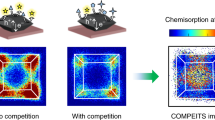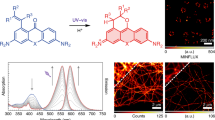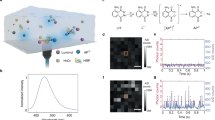Abstract
The palladium-catalysed Suzuki–Miyaura reaction is one of the most important methods for C–C cross-coupling, yet the heterogeneous version of this reaction remains poorly understood. More specifically, the question of whether the reaction occurs on the surface of the catalyst (heterogeneous process) or is promoted by leaching of palladium species in solution (homogeneous phase) is still under debate. Here, we use real-time high spatial resolution microscopy to monitor a palladium-catalysed coupling reaction that produces a highly fluorescent BODIPY dye. We show catalyst migration during the reaction, which we attribute to a dissolution/redeposition mechanism where migrating palladium species become true active sites after attachment to the catalyst support. The observed process is heterogeneous, but the active catalysts (atoms or small clusters) have important mobility, as revealed by the observation of migrating catalytic sites. Our report shows the strength of single-molecule studies for unveiling fundamental mechanisms in heterogeneously catalysed reactions that are otherwise difficult to explore with classical ensemble experiments.

This is a preview of subscription content, access via your institution
Access options
Access Nature and 54 other Nature Portfolio journals
Get Nature+, our best-value online-access subscription
$29.99 / 30 days
cancel any time
Subscribe to this journal
Receive 12 digital issues and online access to articles
$119.00 per year
only $9.92 per issue
Buy this article
- Purchase on Springer Link
- Instant access to full article PDF
Prices may be subject to local taxes which are calculated during checkout





Similar content being viewed by others
Data availability
The data supporting the findings of this study are available in the paper and its Supplementary Information; further data are available from the corresponding author on reasonable request.
References
Miyaura, N. & Suzuki, A. Palladium-catalyzed cross-coupling reactions of organoboron compounds. Chem. Rev. 95, 2457–2483 (1995).
Torborg, C. & Beller, M. Recent applications of palladium-catalyzed coupling reactions in the pharmaceutical, agrochemical, and fine chemical industries. Adv. Synth. Catal. 351, 3027–3043 (2009).
Astruc, D., Lu, F. & Aranzaes, J. R. Nanoparticles as recyclable catalysts: the frontier between homogeneous and heterogeneous catalysis. Angew. Chem. Int. Ed. Engl. 44, 7852–7872 (2005).
Astruc, D. Nanoparticles and Catalysis (Wiley-VCH, 2008).
Chen, Z. et al. A heterogeneous single-atom palladium catalyst surpassing homogeneous systems for Suzuki coupling. Nat. Nanotechnol. 13, 702–707 (2018).
Liu, J. Catalysis by supported single metal atoms. ACS Catal. 7, 34–59 (2017).
Zhang, H., Liu, G., Shi, L. & Ye, J. Single-atom catalysts: emerging multifunctional materials in heterogeneous catalysis. Adv. Energy Mater. 8, 1701343 (2018).
Fihri, A., Bouhrara, M., Nekoueishahraki, B., Basset, J.-M. & Polshettiwar, V. Nanocatalysts for Suzuki cross-coupling reactions. Chem. Soc. Rev. 40, 5181–5203 (2011).
Pérez-Lorenzo, M. Palladium nanoparticles as efficient catalysts for Suzuki cross-coupling reactions. J. Phys. Chem. Lett. 3, 167–174 (2012).
Phan, N. T. S., Van Der Sluys, M. & Jones, C. W. On the nature of the active species in palladium catalyzed Mizoroki–Heck and Suzuki–Miyaura couplings—homogeneous or heterogeneous catalysis, a critical review. Adv. Synth. Catal. 348, 609–679 (2006).
Gaikwad, A. V., Holuigue, A., Thathagar, M. B., ten Elshof, J. E. & Rothenberg, G. Ion- and atom-leaching mechanisms from palladium nanoparticles in cross-coupling reactions. Chem. Eur. J. 13, 6908–6913 (2007).
Schmidt, A. F. & Kurokhtina, A. A. Distinguishing between the homogeneous and heterogeneous mechanisms of catalysis in the Mizoroki–Heck and Suzuki–Miyaura reactions: problems and prospects. Kinet. Catal. 53, 714–730 (2012).
Sigeev, A. S., Peregudov, A. S., Cheprakov, A. V. & Beletskaya, I. P. The palladium slow-release pre-catalysts and nanoparticles in the “phosphine-free” Mizoroki–Heck and Suzuki–Miyaura reactions. Adv. Synth. Catal. 357, 417–429 (2015).
Lee, A. F., Ellis, P. J., Fairlamb, I. J. S. & Wilson, K. Surface catalysed Suzuki–Miyaura cross-coupling by Pd nanoparticles: an operando XAS study. Dalton Trans. 39, 10473–10482 (2010).
Ellis, P. J., Fairlamb, I. J. S., Hackett, S. F. J., Wilson, K. & Lee, A. F. Evidence for the surface-catalyzed Suzuki–Miyaura reaction over palladium nanoparticles: an operando XAS study. Angew. Chem. Int. Ed. Engl. 49, 1820–1824 (2010).
Weiss, S. Fluorescence spectroscopy of single biomolecules. Science 283, 1676–1683 (1999).
Eggeling, C., Fries, J. R., Brand, L., Günther, R. & Seidel, C. A. M. Monitoring conformational dynamics of a single molecule by selective fluorescence spectroscopy. Proc. Natl Acad. Sci. USA 95, 1556–1561 (1998).
Cordes, T. & Blum, S. A. Opportunities and challenges in single-molecule and single-particle fluorescence microscopy for mechanistic studies of chemical reactions. Nat. Chem. 5, 993–999 (2013).
De Cremer, G., Sels, B. F., De Vos, D. E., Hofkens, J. & Roeffaers, M. B. J. Fluorescence micro(spectro)scopy as a tool to study catalytic materials in action. Chem. Soc. Rev. 39, 4703–4717 (2010).
Zhang, Y., Chen, T., Song, P. & Xu, W. Recent progress on single-molecule nanocatalysis based on single-molecule fluorescence microscopy. Sci. Bull. 62, 290–301 (2017).
Tachikawa, T., Wang, N., Yamashita, S., Cui, S.-C. & Majima, T. Design of a highly sensitive fluorescent probe for interfacial electron transfer on a TiO2 surface. Angew. Chem. Int. Ed. Engl. 49, 8593–8597 (2010).
Scaiano, J. C. & Lanterna, A. E. Is single-molecule fluorescence spectroscopy ready to join the organic chemistry toolkit? A test case involving click chemistry. J. Org. Chem. 82, 5011–5019 (2017).
Chen, T. et al. Catalytic kinetics of different types of surface atoms on shaped Pd nanocrystals. Angew. Chem. Int. Ed. Engl. 55, 1839–1843 (2016).
Xu, W., Kong, J. S., Yeh, Y.-T. E. & Chen, P. Single-molecule nanocatalysis reveals heterogeneous reaction pathways and catalytic dynamics. Nat. Mater. 7, 992–996 (2008).
Esfandiari, N. M. & Blum, S. A. Homogeneous vs heterogeneous polymerization catalysis revealed by single-particle fluorescence microscopy. J. Am. Chem. Soc. 133, 18145–18147 (2011).
Ng, J. D. et al. Single-molecule investigation of initiation dynamics of an organometallic catalyst. J. Am. Chem. Soc. 138, 3876–3883 (2016).
Andoy, N. M. et al. Single-molecule catalysis mapping quantifies site-specific activity and uncovers radial activity gradient on single 2D nanocrystals. J. Am. Chem. Soc. 135, 1845–1852 (2013).
Zhou, X. et al. Quantitative super-resolution imaging uncovers reactivity patterns on single nanocatalysts. Nat. Nanotechnol. 7, 237–241 (2012).
Decan, M. R., Impellizzeri, S., Marin, M. L. & Scaiano, J. C. Copper nanoparticle heterogeneous catalytic ‘click’ cycloaddition confirmed by single-molecule spectroscopy. Nat. Commun. 5, 4612 (2014).
Decan, M. R. & Scaiano, J. C. Study of single catalytic events at copper-in-charcoal: localization of click activity through subdiffraction observation of single catalytic events. J. Phys. Chem. Lett. 6, 4049–4053 (2015).
Wang, B. et al. From the molecule to the mole: improving heterogeneous copper catalyzed click chemistry using single molecule spectroscopy. Chem. Commun. 53, 328–331 (2017).
Wang, B., Lanterna, A. E. & Scaiano, J. C. Click chemistry: mechanistic insights into the role of amines using single-molecule spectroscopy. ACS Catal. 7, 8487–8492 (2017).
Elhage, A., Lanterna, A. E. & Scaiano, J. C. Catalytic farming: reaction rotation extends catalyst performance. Chem. Sci. 10, 1419–1425 (2019).
Widegren, J. A. & Finke, R. G. A review of the problem of distinguishing true homogeneous catalysis from soluble or other metal-particle heterogeneous catalysis under reducing conditions. J. Mol. Catal. A 198, 317–341 (2003).
Bayram, E. et al. Is it homogeneous or heterogeneous catalysis derived from [RhCp*Cl2]2? In operando XAFS, kinetic, and crucial kinetic poisoning evidence for subnanometer Rh4 cluster-based benzene hydrogenation catalysis. J. Am. Chem. Soc. 133, 18889–18902 (2011).
Burés, J. A simple graphical method to determine the order in catalyst. Angew. Chem. Int. Ed. Engl. 55, 2028–2031 (2016).
Collins, G., Schmidt, M., O’Dwyer, C., Holmes, J. D. & McGlacken, G. P. The origin of shape sensitivity in palladium-catalyzed Suzuki–Miyaura cross coupling reactions. Angew. Chem. Int. Ed. Engl. 53, 4142–4145 (2014).
Del Zotto, A. & Zuccaccia, D. Metallic palladium, PdO, and palladium supported on metal oxides for the Suzuki–Miyaura cross-coupling reaction: a unified view of the process of formation of the catalytically active species in solution. Catal. Sci. 7, 3934–3951 (2017).
Amoroso, F., Colussi, S., Del Zotto, A., Llorca, J. & Trovarelli, A. An efficient and reusable catalyst based on Pd/CeO2 for the room temperature aerobic Suzuki–Miyaura reaction in water/ethanol. J. Mol. Catal. A 315, 197–204 (2010).
Carter, A. R. et al. Stabilization of an optical microscope to 0.1 nm in three dimensions. Appl. Opt. 46, 421–427 (2007).
Bloeß, A. et al. Optical far-field microscopy of single molecules with 3.4 nm lateral resolution. J. Microsc. 205, 76–85 (2002).
Johnson, D. S., Toledo-Crow, R., Mattheyses, AlexaL. & Simon, SanfordM. Polarization-controlled TIRFM with focal drift and spatial field intensity correction. Biophys. J. 106, 1008–1019 (2014).
Zhang, H., Kwong, F. Y., Tian, Y. & Chan, K. S. Base and cation effects on the Suzuki cross-coupling of bulky arylboronic acid with halopyridines: synthesis of pyridylphenols. J. Org. Chem. 63, 6886–6890 (1998).
Braga, A. A. C., Morgon, N. H., Ujaque, G. & Maseras, F. Computational characterization of the role of the base in the Suzuki−Miyaura cross-coupling reaction. J. Am. Chem. Soc. 127, 9298–9307 (2005).
Lennox, A. J. J. & Lloyd-Jones, G. C. Transmetalation in the Suzuki–Miyaura coupling: the fork in the trail. Angew. Chem. Int. Ed. Engl. 52, 7362–7370 (2013).
Miyaura, N. Cross-coupling reaction of organoboron compounds via base-assisted transmetalation to palladium(ii) complexes. J. Organomet. Chem. 653, 54–57 (2002).
Thomas, A. A. & Denmark, S. E. Pre-transmetalation intermediates in the Suzuki–Miyaura reaction revealed: the missing link. Science 352, 329–332 (2016).
Thomas, A. A., Zahrt, A. F., Delaney, C. P. & Denmark, S. E. Elucidating the role of the boronic esters in the Suzuki–Miyaura reaction: structural, kinetic, and computational investigations. J. Am. Chem. Soc. 140, 4401–4416 (2018).
Thomas, A. A., Wang, H., Zahrt, A. F. & Denmark, S. E. Structural, kinetic, and computational characterization of the elusive arylpalladium(ii) boronate complexes in the Suzuki–Miyaura reaction. J. Am. Chem. Soc. 139, 3805–3821 (2017).
Biffis, A., Centomo, P., Del Zotto, A. & Zecca, M. Pd metal catalysts for cross-couplings and related reactions in the 21st century: a critical review. Chem. Rev. 118, 2249–2295 (2018).
Lipshutz, B. H., Tasler, S., Chrisman, W., Spliethoff, B. & Tesche, B. On the nature of the ‘heterogeneous’ catalyst: nickel-on-charcoal. J. Org. Chem. 68, 1177–1189 (2003).
Elhage, A., Lanterna, A. E. & Scaiano, J. C. Tunable photocatalytic activity of palladium-decorated TiO2: non-hydrogen-mediated hydrogenation or isomerization of benzyl-substituted alkenes. ACS Catal. 7, 250–255 (2017).
Deschout, H. et al. Precisely and accurately localizing single emitters in fluorescence microscopy. Nat. Methods 11, 253–266 (2014).
Karolin, J., Johansson, L. B. A., Strandberg, L. & Ny, T. Fluorescence and absorption spectroscopic properties of dipyrrometheneboron difluoride (BODIPY) derivatives in liquids, lipid membranes, and proteins. J. Am. Chem. Soc. 116, 7801–7806 (1994).
Wittmershaus, B. P., Skibicki, J. J., McLafferty, J. B., Zhang, Y.-Z. & Swan, S. Spectral properties of single BODIPY dyes in polystyrene microspheres and in solutions. J. Fluoresc. 11, 119–128 (2001).
Magde, D., Rojas, G. E. & Seybold, P. G. Solvent dependence of the fluorescence lifetimes of xanthene dyes. Photochem. Photobiol. 70, 737–744 (1999).
Kubin, R. F. & Fletcher, A. N. Fluorescence quantum yields of some rhodamine dyes. J. Lumin. 27, 455–462 (1982).
Cser, A., Nagy, K. & Biczók, L. Fluorescence lifetime of Nile red as a probe for the hydrogen bonding strength with its microenvironment. Chem. Phys. Lett. 360, 473–478 (2002).
Acknowledgements
This work was supported by the Natural Sciences and Engineering Research Council of Canada, the Canada Foundation for Innovation, the Canada Research Chairs Program and the German National Academy of Sciences Leopoldina (grant no. LPDS 2017-15 to P.C.).
Author information
Authors and Affiliations
Contributions
P.C., D.S. and J.C.S. conceived the research. P.C. and D.S. performed the experiments and analysed the data. P.C. and D.S. performed the syntheses. All authors contributed to the manuscript preparation.
Corresponding author
Ethics declarations
Competing interests
The authors declare no competing interests.
Additional information
Publisher’s note Springer Nature remains neutral with regard to jurisdictional claims in published maps and institutional affiliations.
Supplementary information
Supplementary Information
Supplementary Methods, Figs. 1–46, Tables 1 and 2, Notes 1–4 and references.
Rights and permissions
About this article
Cite this article
Costa, P., Sandrin, D. & Scaiano, J.C. Real-time fluorescence imaging of a heterogeneously catalysed Suzuki–Miyaura reaction. Nat Catal 3, 427–437 (2020). https://doi.org/10.1038/s41929-020-0442-0
Received:
Accepted:
Published:
Issue Date:
DOI: https://doi.org/10.1038/s41929-020-0442-0
This article is cited by
-
Structural transformations of solid electrocatalysts and photocatalysts
Nature Reviews Chemistry (2021)
-
Imaging spatiotemporal evolution of molecules and active sites in zeolite catalyst during methanol-to-olefins reaction
Nature Communications (2020)



